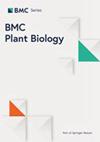通过重复组分析和比较核型分析首次了解紫草科(Pulmonaria officinalis)植物的基因组
IF 4.3
2区 生物学
Q1 PLANT SCIENCES
引用次数: 0
摘要
紫草属(紫草科)在分类学上是一个复杂的物种群,形态上的相似性与显著的核变异形成鲜明对比。二倍体状态下存在不同数目的染色体,这表明在染色体重排(非整倍体)之后发生了多次杂交/多倍体化事件。遗憾的是,基因组的系统发育关系和进化尚未阐明。我们的研究重点是 P. officinalis 组,这是分布最广的物种群,包括两个形态相似但染色体数目不同的物种,即 P. obscura(2n = 14)和 P. officinalis(2n = 16)。我们还研究了形态上与 P. officinalis(花园逃逸种)相似的观赏栽培品种,这些栽培品种的起源尚不清楚。在此,我们对这些近缘物种的基因组大小和重复组动态进行了试验性研究,以获得有关其基因组和染色体结构的新信息。流式细胞术证实,P. obscura 和 P. officinalis 的基因组大小与染色体数量存在显著差异。对基因组脱脂数据进行的全基因组重复组分析表明,反转座子是最丰富的重复类型,Ty3/Gypsy元件的比例较高,主要以Tekay系为代表。比较分析表明,逆转座子没有物种特异性,不同物种之间的拷贝数也没有明显差异。以卫星 DNA 为代表的一组新的染色体特异性细胞遗传标记表明,欧芹的染色体结构与欧芹相比更加多变。比较核型分析表明,从这两个物种的混合种群中收集到的 2n = 15 的假定杂交种具有杂交起源,并概述了观赏园林逃逸物种的起源,推测这些逃逸物种来自 P. officinalis 复合物。对两个形态相似的 P. officinalis 组物种进行大规模基因组大小分析和重复组特征分析,提高了我们对基因组动态和核型结构差异的认识。我们发现了一组新的染色体特异性细胞遗传学地标,并利用它们揭示了与 P. officinalis 形态相似的假定杂交种和观赏栽培品种的起源。本文章由计算机程序翻译,如有差异,请以英文原文为准。
First insight into the genomes of the Pulmonaria officinalis group (Boraginaceae) provided by repeatome analysis and comparative karyotyping
The genus Pulmonaria (Boraginaceae) represents a taxonomically complex group of species in which morphological similarity contrasts with striking karyological variation. The presence of different numbers of chromosomes in the diploid state suggests multiple hybridization/polyploidization events followed by chromosome rearrangements (dysploidy). Unfortunately, the phylogenetic relationships and evolution of the genome, have not yet been elucidated. Our study focused on the P. officinalis group, the most widespread species complex, which includes two morphologically similar species that differ in chromosome number, i.e. P. obscura (2n = 14) and P. officinalis (2n = 16). Ornamental cultivars, morphologically similar to P. officinalis (garden escapes), whose origin is unclear, were also studied. Here, we present a pilot study on genome size and repeatome dynamics of these closely related species in order to gain new information on their genome and chromosome structure. Flow cytometry confirmed a significant difference in genome size between P. obscura and P. officinalis, corresponding to the number of chromosomes. Genome-wide repeatome analysis performed on genome skimming data showed that retrotransposons were the most abundant repeat type, with a higher proportion of Ty3/Gypsy elements, mainly represented by the Tekay lineage. Comparative analysis revealed no species-specific retrotransposons or striking differences in their copy number between the species. A new set of chromosome-specific cytogenetic markers, represented by satellite DNAs, showed that the chromosome structure in P. officinalis was more variable compared to that of P. obscura. Comparative karyotyping supported the hybrid origin of putative hybrids with 2n = 15 collected from a mixed population of both species and outlined the origin of ornamental garden escapes, presumably derived from the P. officinalis complex. Large-scale genome size analysis and repeatome characterization of the two morphologically similar species of the P. officinalis group improved our knowledge of the genome dynamics and differences in the karyotype structure. A new set of chromosome-specific cytogenetic landmarks was identified and used to reveal the origin of putative hybrids and ornamental cultivars morphologically similar to P. officinalis.
求助全文
通过发布文献求助,成功后即可免费获取论文全文。
去求助
来源期刊

BMC Plant Biology
生物-植物科学
CiteScore
8.40
自引率
3.80%
发文量
539
审稿时长
3.8 months
期刊介绍:
BMC Plant Biology is an open access, peer-reviewed journal that considers articles on all aspects of plant biology, including molecular, cellular, tissue, organ and whole organism research.
 求助内容:
求助内容: 应助结果提醒方式:
应助结果提醒方式:


